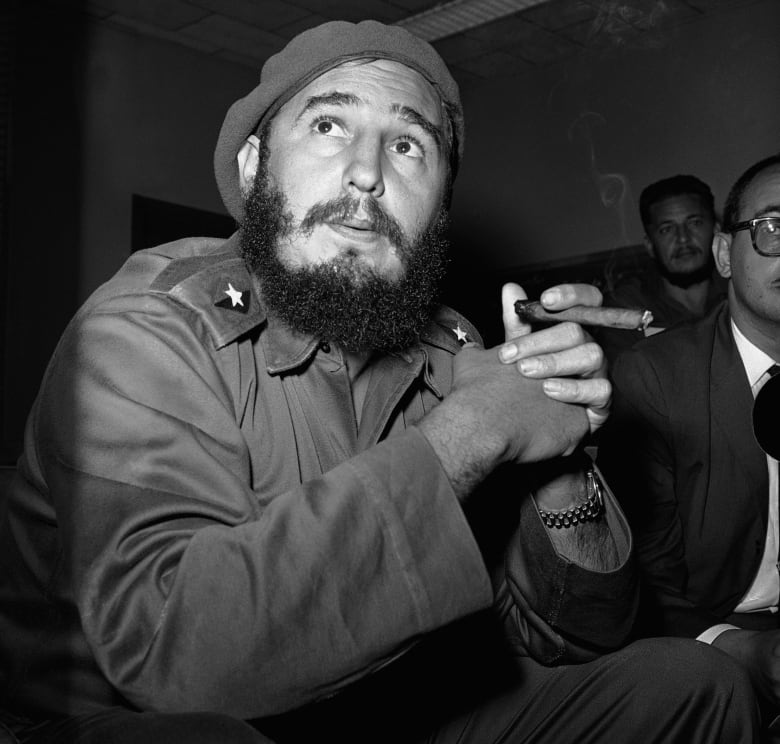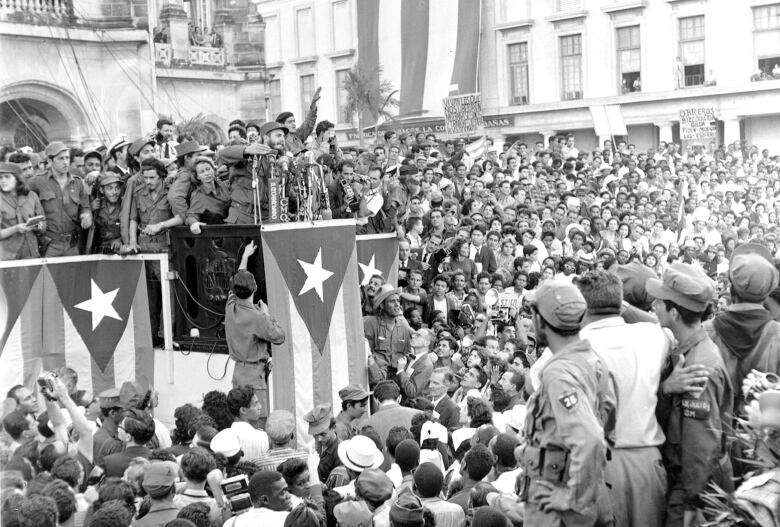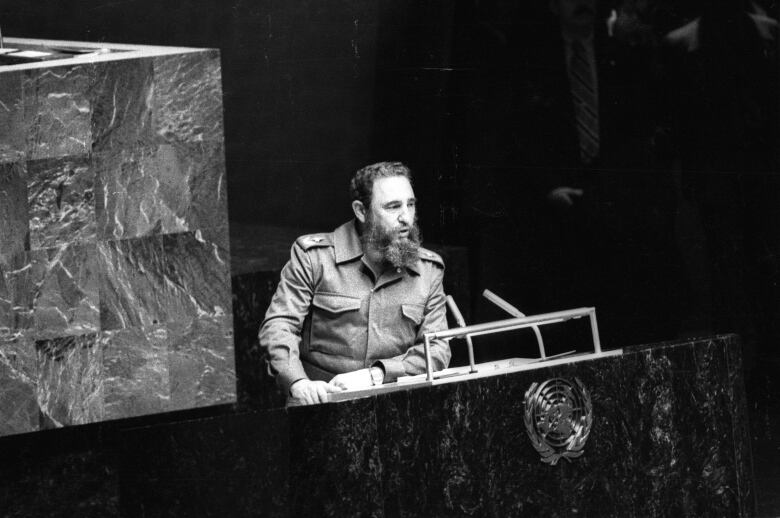Cuba's Fidel Castro dead at 90
Cuban President Raul Castro announces death on state media
After years of false rumours about his death, Fidel Castro, the ailing former leader of Cuba, has died at the age of 90.
Cuban President Raul Castroannounced the death of his brotheron Cuban state media.He ended the announcement by shouting the revolutionary slogan: "Toward victory, always!"
Castro was one of the most divisive figures of modern history. To some, he was a revolutionary icon defending a socialist ideal against the encroachment of capitalism and imperialism. To others, he was a totalitarian dictator who ran a repressive government that quashed individual rights and carried out political executions.
Castro's system of one-man and one-party rule kept him in power for 49 years, the longest of any head of government in the world. For most of that time, he was a thorn in the side of the U.S., which carried out several failed assassination attempts against him, as well as the infamous botched Bay of Pigs invasion.
- Fidel Castro's death greeted with celebration and sorrow
- Fidel Castro was 'larger than life,' says Justin Trudeau
The U.S. also put in place tough economic and travel sanctions against Cuba, barring U.S. citizens from travelling to or doing business with the country. The sanctions have remained in place for decades, but in December2014 U.S. PresidentBarackObamaannounced his government wouldtake steps to restore full diplomatic relations with Cuba.
The revolutionary as a young man
Castro was born on Aug. 13, 1926, in what was thenOrienteprovince in the eastern part of the island of Cuba.

The son of a sugar cane farmer, Castro attended Roman Catholic schools and established an early reputation as a gifted athlete.
He studied law at the University of Havana, where he became actively engaged in politics. At the age of 21, he joined a group of Cubans and exiles from the Dominican Republic intent on overthrowing the Dominican dictator Gen.RalaelLeonidasTrujilloMolina.
After completing his degree and becoming a lawyer, Castro joined the Cuban People's Party, a reformist movement.
- Fidel Castro slams Barack Obama's Cuba visit, 'honey-coated' comments
- Canada won't change stance on Cuba even with Trump in White House: Trudeau
Castro was only 27 when on July 26, 1953, he launched an attack on the Moncada army barracks in Santiago de Cuba, then under the control of Gen. Fulgencio Batista, who had seized power in Cuba in a military coup a year earlier. The attack failed, with Castro and most of his fighters captured or killed, but the date went on to become Cuba's most important holiday.
Castro was arrested and eventually sentenced to 15 years in prison but was pardoned after only two years. He went into exile in Mexico, where he assembled a group of revolutionaries dubbed the 26th of July Movement. A year later, in 1956, with the help of future rebel icon Ernesto (Che) Guevara and other opponents of the Batista regime, Castro returned to Cuba.

In January 1959, with a mere 800 guerrilla fighters, Castro and his troops managed to defeat Batista's professional army of 30,000 soldiers, forcing Batista to flee Havana under the cover of night.
Castro and his allies seized power and began implementing a series of socialist and Marxist reforms, including nationalizing land, businesses and private schools; redistributing land; implementing programs to raise literacy and education levels among the rural population; and creating a national health care system.
The reforms drove many Cubans and foreign investors, primarily those from the U.S., off the island and provoked the start of what was to be a long period of antagonism between Cuba and the U.S.
Many were also spooked by the public executions of Batista supporters that took place - without trial - in the initial months after the coup.
U.S. antagonist
After his overthrow of Batista's dictatorship, Castro enjoyed acclaim not only with the masses at home but also internationally. He was initially popular even in the U.S., but those relations quickly soured.
As part of its nationalization program, Castro's government began to confiscate private land and property, much of it owned by wealthy Americans, who controlled the bulk of Cuba's sugar industry and had wielded significant economic and political influence in the country in the first half of the 20th century.

He further irritated and alarmed the U.S. by aligning Cuba with the Soviet Union. Cuba benefited from this arrangement by having a regular buyer for its sugar and a supply of vital economic and military aid.
Castro frequently denounced the U.S. as an imperialist, capitalist foe of the socialist revolution, accusing it of trying to undermine his new government.
Dwight Eisenhower, who was U.S. president when Castro seized power, ended sugar purchases from Cuba, then placed an embargo on all exports to Cuba, except food and medicine. One of Eisenhower's last legislative acts was to break diplomatic relations with Cuba in January 1961.
Bay of Pigs
When John F. Kennedy became president in 1961, he inherited a plan drafted by the CIA during the Eisenhower administration to have U.S.-trained Cuban exiles carry out an invasion of their home country. Kennedy decided to carry it out in April 1961, choosing to invade by way of a remote swamp region on Cuba's southern coast called the Bay of Pigs in an effort to disguise the U.S.'s role in the covert action.
Several U.S. bombers, disguised to look like Cuban air force planes and piloted by Cuban exiles, began the invasion by first launching a series of air strikes against air bases in Cuba, but they missed many of the targets and were unmasked as U.S. aircraft.
- ANALYSIS:Obama'sCuban foray: 'Too much goodwill' to turn back the Cold War clock
- Timeline: The Cuban missile crisis
The invasion force of about 1,400 Cuban exiles, trained by the CIA at camps in Guatemala, didn't fare much better. They attempted to gain a beachhead at the Bay of Pigs but came under heavy fire - from the air and from the several thousand troops Castro dispatched to the region.
In the end, more than 100 invading troops were killed and almost 1,200 captured. Castro eventually allowed the captured Cuban exiles to return to the U.S. in exchange for about $53 million worth of food and medicine.
The Bay of Pigs invasion was a total failure for the U.S. and solidified support for Castro in Cuba and throughout Latin America.
Missile crisis
A little over a year later, Cuba was at the centre of another international incident after the U.S. discovered in October 1962 that the Soviet Union was building missile installations on the island equipped with missiles that could reach the U.S.

A tense standoff ensued that lasted several days and had the world fearing a nuclear war. It was defused after the Soviets agreed to dismantle the missiles if the Americans lifted their naval blockade of Cuba and agreed not to invade Cuba.
The fall of the Berlin Wall in 1989 and the subsequent disintegration of the Soviet Union was a blow to Cuba's economic fortunes and diminished Castro's stature on the international scene.
Cuba ended the 20th century a much poorer nation than when Castro's revolutionary period began, experiencing food and fuel shortages throughout the early 2000s.
Rumours of death
There have been many attempts to assassinate Castro over the years, with one particularly clumsy attempt centered on presenting him with the gift of an exploding cigar. There have also been numerous reports of Castro's death or his incapacitation by illness.
In 1994, he was said to have died from a stroke. In 1996, the report was he had severe lung cancer. Another rumour had him suffering either from Alzheimer's or a mysterious fatal disease that turns the brain to mush.
When he was reported to have died in 1997, Castro, known for making meandering speeches of epic length, dispelled the rumours by giving a seven-hour speech at the opening session of the Communist Party congress.
"Every once in a while, they kill me off," Castro has quipped to reporters. "The day I die, no one will believe it."
Castro relinquishes power
However, illness eventually did force the Cuban revolutionary to step away from power.
In an official proclamation released on July 31, 2006, Castro provisionally delegated most of his official duties to his brother Raul including the positions of president and head of the Communist Party.
In February 2008, Castro announced he was officially stepping down as president, and Raul was formally picked to succeed him by the country's parliament a few days later.
The tireless revolutionary continued to appear in public as much as he could and even took the occasional meeting with a head of state or dignitary.
He visited frequently with Venezuelan President Hugo Chavez in 2011 and 2012 when the latter was in Cuba for cancer treatment.
Corrections
- An earlier version of this story said Castro launched an attack on the Moncada army barracks in Havana in 1953. In fact, the Moncada barracks are in Santiago de Cuba.Nov 26, 2016 2:23 AM ET
With files from The Canadian Press, Associated Press, Reuters

















_(720p).jpg)


 OFFICIAL HD MUSIC VIDEO.jpg)
.jpg)



























































































